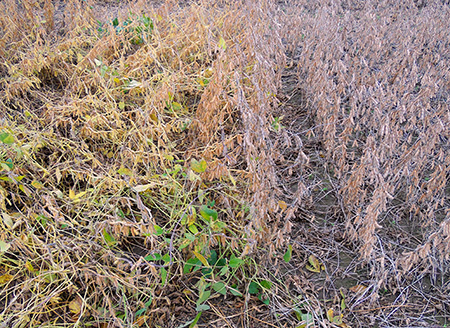Recommendations for harvesting lodged soybeans
Specific recommendations for reducing losses and improving efficiency when harvesting lodged soybeans.

Significant lodging has occurred in some Michigan soybean fields in 2021 (Photo 1). The areas of the state that are most impacted are the thumb and irrigated fields in the southwest. Lodging is most prevalent in areas within irrigated fields that were double-watered or hit by the end gun. Lodged soybeans slow down harvest operations and lead to harvest losses as the plants are more difficult to cut and gather into the combine. Soybean producers can reduce harvest losses due to lodging by carefully adjusting and operating their combines. The latest Michigan State University Extension recommendations for reducing harvest losses in lodged soybeans are listed below.
Decrease your ground speed to 2.5 to 3 mph.
Position the cutter bar as close to the ground as possible.
Angle the pickup fingers on the reel back slightly to more aggressively pull the lodged plants to the cutter bar. Reduce the angle of the fingers if the plants are riding over the top of the reel.
Move the reel axle forward so that it is 9-12 inches ahead of the cutter bar.
Contact the manufacturer for specific recommendations if using an air-assisted reel in lodged soybeans. Moving the reel forward to pick up lodged plants decreases the performance of air-assisted reels. Pivot the down tubes above the crop if this option is available or remove the entire air manifold.
Operate the reel as low as necessary to pick up lodged plants without causing them to ride over the top of the reel. Raise the reel if this happens.
Install vine lifters on the cutter bar in conditions of severe lodging.
When the plants are lodged in one direction, use vine lifters and travel at a 30-degree angle to the direction of lodging. Alternatively, harvest the lodged plants traveling opposite to direction they are leaning.
Increase the reel speed relative to the ground speed. It may be challenging to maintain the correct ground and reel speed combination in lodged beans with brittle pods. When ground speed is too fast relative to reel speed, the cutter bar will ride over some plants. When the reel speed is too fast relative to ground speed, the reel may shatter the pods. The reel should run 10 to 20 percent faster than ground speed under ideal conditions. However, in lodged beans, increase the reel speed incrementally up to a maximum of 50 percent faster than the ground speed. If the reel is shattering pods, decrease the reel speed to the point when the shattering stops. If the cutter bar rides over lodged plants, decrease your ground speed.
Make one adjustment at a time and frequently stop to evaluate your progress in reducing gathering losses.

Finally, try to identify the cause or causes of the lodging. The most likely causes are excessive rainfall or irrigation during the vegetative and early reproductive stages, high populations, low potassium soil test levels, and variety selection. Soybean varieties differ in susceptibility to lodging, and producers should consider this characteristic when selecting varieties.
Varietal resistance to lodging is depicted in Photo 2, taken at the MSU soybean variety performance trial near Hamilton, Michigan, in 2016. The two varieties were planted at the same planting rate (160,000 seeds per acre), fertilized the same, and experienced the same weather conditions. The variety on the left is badly lodged, and the variety on the right is standing well. Planting dates may also affect the potential to lodge as mid-May to mid-June planting dates generally produce the tallest plants.
Soybean producers who experienced significant lodging this season can reduce their harvest losses through careful adjustment and operation of the combine and decrease the potential for future lodging problems by changing a few key management practices.
This article was produced by a partnership between MSU Extension and the Michigan Soybean Checkoff program.



 Print
Print Email
Email